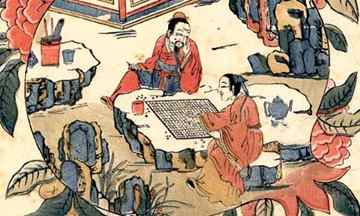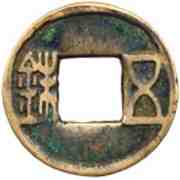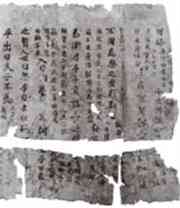It's hard to avoid superlatives when describing China. The country's landmass is enormous, covering roughly 9.6m sq km, with a huge population of some 1.3 billion people. Having recently overtaken Japan as the world's second largest economy, it is well on the way to cementing a dominant position on the global markets. Yet one key fact to understand about China is that these developments are seen as nothing new, but a return to the old order of things.
 During the Tang dynasty (AD618-907) a census from the year 750 revealed a population of one million within the walls of the capital city, Chang'an, making it the largest city in the world at the time. And it was not just its size that was spectacular. The Chinese capital was probably the most powerful economic centre in the ancient world, attracting traders from the west who travelled along the Silk Road to buy and sell. There were Arabs, Persians and Sogdian traders from Samarkand, whose spiritual needs were served by mosques and Zoroastrian temples in the cosmopolitan city.
During the Tang dynasty (AD618-907) a census from the year 750 revealed a population of one million within the walls of the capital city, Chang'an, making it the largest city in the world at the time. And it was not just its size that was spectacular. The Chinese capital was probably the most powerful economic centre in the ancient world, attracting traders from the west who travelled along the Silk Road to buy and sell. There were Arabs, Persians and Sogdian traders from Samarkand, whose spiritual needs were served by mosques and Zoroastrian temples in the cosmopolitan city.
The First Emperor
The Chinese pride themselves on having the longest continuous civilisation in the world, although the massive state we know today took time to develop. From isolated Neolithic settlements scattered across the landmass, the great bronze age cultures of the Shang (c1500–c1050BC) and Zhou (c1050–221BC) developed in the north along the Yellow River.
As Zhou polity fell apart, the northern part of China was divided between smaller states, many of which built defensive walls, precursors of the Great Wall. In 221BC, the First Emperor conquered all the other states and established his rule over a unified state stretching from the north of Beijing down to the northern border of the Guangdong province and from the far western Sichuan area to the eastern seaboard. This was most of the China we know today – in fact the name "China" derives from the First Emperor's home state of Qin (pronounced "Chin") on the Wei river.
The First Emperor quickly established an administration to maintain control of this vast landmass. Armed with legal handbooks, texts inscribed on narrow slips of bamboo, tied together and rolled up like tiny bamboo blinds, his officials established a system of law: they set out official standards for weights and measures that were checked rigorously – swindling offences were punished with sentences of hard labour on imperial walls and roads – and they conducted forensic investigations into suspicious deaths.
 A standardised coinage was also introduced: a new form of a circular coin with a square hole in the middle, which was used for more than 2,000 years until 1911. Even now the shape forms a major decorative emblem in ceramics and textiles.
A standardised coinage was also introduced: a new form of a circular coin with a square hole in the middle, which was used for more than 2,000 years until 1911. Even now the shape forms a major decorative emblem in ceramics and textiles.
In China, the First Emperor's rule is traditionally remembered as that of an unnecessarily harsh tyrant (contrasting with the "good guys" from the Han dynasty). Yet the First Emperor also managed to set up a relatively modern, forward-looking legal system that lasted 2,000 years, whereby trained administrators were sent out all over the country to govern by statute.
What was right and what was wrong was now no longer subject to the whim of erratic autocrats, but out there for everyone to see. If you stole a sheep, you knew the consequences. China's legal system was described by Jesuit missionaries in the 18th century and admired by Enlightenment thinkers who saw it as a great improvement on rule by hereditary aristocrats.
Furthermore, a legal code was promoted that included a concession about legal responsibility. Unlike in Europe, though, it was not based on a person's age. In China even today, on the doors of buses and beside ticket offices in stations and at tourist sites, there is a metre-high mark, indicating that those under a metre in height can enter or travel for free.
Writing
Another of the First Emperor's decrees was a standardisation of the Chinese script. Though it had been in use for around two millennia, the script had developed into different local forms during the so-called Spring and Autumn period (770–476BC) and Warring States period (475–221BC).
 After the rule of the First Emperor, there was some further standardisation during the Han dynasty (206BC–AD220), which created the unifying script that has been used ever since. Though it is clear that the pronunciation of Chinese has changed over the millennia, an educated person can still read Han dynasty texts with a fair amount of ease.
After the rule of the First Emperor, there was some further standardisation during the Han dynasty (206BC–AD220), which created the unifying script that has been used ever since. Though it is clear that the pronunciation of Chinese has changed over the millennia, an educated person can still read Han dynasty texts with a fair amount of ease.
The sheer difference of Chinese script from other writing systems – non-alphabetic, with tens of thousands of separate characters – is a source of national pride. The status of the art of calligraphy is equal to that of painting and has, at times, been higher.
Even Mao Zedong, better known in the west as a communist tyrant bent on destroying traditional Chinese culture, prided himself on the wild, "grass-style" calligraphy in which he wrote his poems.
With the ancient language came ancient traditions and beliefs. In another pattern established by the First Emperor, it was customary for rulers to travel the country, offering sacrifices on the sacred mountains to appease the gods and please rain-bearing dragons.
These tours also enabled the emperors to gain an impression of how well their local officials were administering the country, maintaining the delicate balance between the collection of grain and other goods such as tax, and sustaining the life of the peasants by supplying grain relief in times of shortage and keeping up flood defences along China's turbulent rivers.
Though the Ming emperors (AD1368–1644) were inclined to stay at home, their successors, the invading Manchus from the north-east who established the Qing dynasty (1644–1911), revived the practice with enthusiasm. They particularly favoured southern China with their "southern tours of inspection", known as nan xun. The Kangxi emperor (1654–1722) and the Qianlong emperor (1711–1799) were particularly interested in the south, and in southern food and culture.
These northerners from the cold Manchurian plains were particularly impressed by the rich, rice-growing, silk-producing cultural centres of Hangzhou, Suzhou and Wuxi. The Qianlong emperor commissioned a copy of the Jichangyuan (Garden of Ease of Mind) in Wuxi to be constructed in the Summer Palace outside Beijing, where it can still be seen today. Both emperors enjoyed southern food so much they retrained their personal cooks – southern fruits such as lychees and mangoes were soon shipped up the Grand Canal for the imperial kitchens.
A more sinister aspect of the traditional respect for language and script is China's long tradition of censorship. It is said that in 213BC, the First Emperor, enraged by conservative critics, ordered a great bonfire in which ancient Confucian texts were destroyed.
In 1772, as part of a massive collection of texts to form a huge imperial encyclopaedia, the Qianlong emperor also instructed his officials to seek out seditious works that criticised Manchu rule in what became known as "the literary inquisition of Qianlong".
During the Cultural Revolution (1966–1976) in a bid to destroy the "four olds" – old customs, culture, habits and ideas – vast quantities of books, paintings, family photographs and works of art were destroyed in a campaign that was remarkably similar to that of the First Emperor's burning of the books.
Innovation and invention
The technological innovations of China's past not only enabled the construction of massive canal networks for transport and improved agricultural techniques but also helped make possible complex and beautiful art objects. They range from the dramatic bronzes of the Shang and Zhou, through the three-coloured ceramic camels of the Tang and the monochrome elegance of Song porcelains (960–1279), to the embroidered robes of the Qing.
Museums all over the world display aspects of China's artistic achievements. Many demonstrate the ingenuity of China's craftsmen, often working without external stimuli but making their own discoveries.
The massive bronzes of 3,000 years ago are unlike those found anywhere else in the world. They were made not by the lost-wax process but in ceramic moulds – testimony to the skill of the ceramic workers as well as the bronze founders. Porcelain was made in China and perfected a thousand years before European ceramicists groped their way towards the secret of its manufacture.
Silk cultivation and weaving were invented in China many thousands of years ago: cut silk cocoons have been discovered in Neolithic sites and silk fabrics survive from Warring States tombs. Silk is probably China's most magical export: a fine yet strong material that was exported along the Silk Road to Rome in the second century BC.
The Romans mistakenly believed that it was combed from trees, so the secret of its origin and production were not known outside China until AD522, when production began in Byzantium.
Porcelain began to be exported from China in great quantities in the late Tang dynasty and, as European ships began to arrive, first in south-east Asia and eventually in 17th century China, porcelain became a very popular commodity, with European houses filling up with blue and white dishes and bowls.
Paper and printing
Technological achievements such as gunpowder and the maritime compass are often cited as some of China's most influential gifts to the world. Yet perhaps the greatest legacy was the invention of paper, an essential prerequisite for printing and mass production.
Paper and printing were both invented in China – archaeologists have found paper remains from the second century BC, though according to the standard history of the Han dynasty, the first official mention of the technology was in AD 105 when the imperial factories officially reported its production to the emperor.
Used to make rubbings of significant stone inscriptions such as the Confucian classics in the second century AD, the mass production of paper must have played a part in the invention of woodblock printing in China in about the sixth century, opening up the possibility of cheap mass communication long before Gutenberg's invention of the printing press in Europe.
Like silk, paper was used along the Silk Road from the third century BC and by the 10th century had reached Sicily and Spain through the Arab conquests.
Paradoxically, even though Chinese products spread across the world to great acclaim, the country itself was little known outside Asia. The arrival of the western nations, intent on trade, coincided with China's decline in the 19th and 20th centuries, a period that now looks like a very short blip in China's long history of economic and cultural success.
The decline was internal, caused by expensive wars waged by the Qing emperors, by population growth and a failure to maintain local order. And it was exacerbated by the impatient pressure of western traders, culminating in the two Opium Wars (1839–1842 and 1856).
The 20th century saw a disastrous period of division and the cruel Japanese invasion, followed by a civil war, after which Mao Zedong and the Communist Party took power in 1949. Since the death of Mao in 1976, new policies have seen the gradual growth of China to its present economic success.
Despite its cultural heritage and the dramatic performance of the national economy, and perhaps partly because of the knocks it took in the Cultural Revolution, China has been slow to recover confidence after 200 years of disaster and disunion.
There is a widespread tendency to dwell on the humiliation of the Opium Wars, and to regard any setback as a further humiliation of the same sort. China's failure to secure the 2000 and 2004 Olympic Games still rankles, despite the extraordinary spectacle of the 2008 Beijing Olympics.
Even the existence of Chinese porcelain in European museums is sometimes resented and regarded as loot even though the vast majority of the pieces were acquired quite legitimately.
As China's economy takes off, perhaps sensitivity to 19th century humiliations can be overcome by pride in the earlier past. Occasionally one gets a glance of the self-belief that China's ancient memory can engender. In the 1980s, I met an old monk on the Buddhist mountain of Jiuhua Shan.
"England..." he said after I had introduced myself. "You have a queen, don't you? She must be very old by now". Only as I started my descent did I realise that he had been thinking of Queen Victoria.
Author: Frances Wood | Source: Guardian [November 11, 2010]